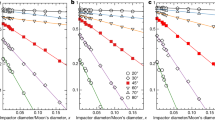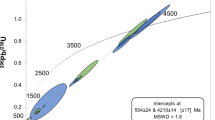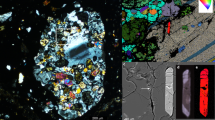Abstract
Micrometeorites are terrestrially collected, extraterrestrial particles smaller than about 1 mm, which account for most of the mass being accreted to the Earth1,2. Compared with meteorites, micrometeorites more completely represent the Earth-crossing meteoroid complex3,4 and should include fragments of asteroids, comets, Mars and our Moon, as well as pre-solar and interstellar grains3,6. Previous measurements of the flux of micrometeoroids that survive to the Earth's surface have large uncertainties owing to the destruction of particles by weathering7,8,9, inefficiencies in magnetic collection or separation techniques7,8,9, low particle counts10,11, poor age constraint7,8,9,12,13 or highly variable concentrating processes12,13. Here we describe an attempt to circumvent these problems through the collection of thousands of well preserved and dated micrometeorites from the bottom of the South Pole water well, which supplies drinking water for the Scott–Amundsen station. Using this collection, we have determined precise estimates of the flux and mass distribution for 50–700-µm cosmic spherules (melted micrometeorites). Allowing for the expected abundance of unmelted micrometeorites14 in the samples, our results indicate that about 90% of the incoming mass of submillimetre particles evaporates during atmospheric entry. Our data indicate the loss of glass-rich and small stony spherules from deep-sea deposits7,8, and they provide constraints for models describing the survival probability of micrometeoroids15,16.
This is a preview of subscription content, access via your institution
Access options
Subscribe to this journal
Receive 51 print issues and online access
$199.00 per year
only $3.90 per issue
Buy this article
- Purchase on Springer Link
- Instant access to full article PDF
Prices may be subject to local taxes which are calculated during checkout



Similar content being viewed by others
References
Love, S. G. & Brownlee, D. E. Adirect measurement of the terrestrial mass accretion rate of cosmic dust. Science 262, 550–553 (1993).
Peucker-Ehrenbrink, B. Accretion of extraterrestrial matter during the last 80 million years and its effect on the marine osmium isotope record. Geochim. Cosmochim. Acta 60, 3187–3196 (1996).
Brownlee, D. E. in The Sea (ed. Emiliani, C.) Ch. 19 (Wiley, New York, 1981).
Brownlee, D. E., Bates, B. & Schramm, L. The elemental composition of stony cosmic spherules. Meteorit. Planet. Sci. 32, 157–175 (1997).
Bradley, J. P., Sandford, S. A. & Walker, R. M. in Meteorites and the Early Solar System (eds Kerridge, J. F. & Matthews, M. S.) 861–895 (Univ. Arizona Press, Tucson, 1988).
Brownlee, D. E. et al. Identification of cometary and asteroidal particles in stratospheric IDP collecitons. Lunar Planet. Sci. XXIV, 205–206 (1993).
Murrell, M. T., Davis, P. A., Nishiizumi, K. & Millard, H. T. Deep-sea spherules from Pacific clay: Mass distribution and influx rate. Geochim. Cosmochim. Acta 44, 2067–2074 (1980).
Kyte, F. T. Analyses of Extraterrestrial Materials in Terrestrial SedimentsThesis (Univ. California, Los Angeles((1983).
Peng, H. & Lui, Z. Measurement of the annual flux of cosmic dust in deep-sea sediments. Meteoritics 24, 315 (1989).
Yiou, F. & Raisbeck, G. M. Cosmic spherules from an Antarctic ice core. Meteoritics 22, 539–540 (1987).
Yiou, F., Raisbeck, G. M. & Jehanno, C. Influx of cosmic spherules to the Earth during the last ∼105 years as deduced from concentrations in Antarctic ice cores. Meteoritics 24, 344 (1989).
Maurette, M., Jehanno, C., Robin, E. & Hammer, C. Characteristics and mass distribution of extraterrestrial dust from the Greenland ice cap. Nature 328, 699–702 (1987).
Maurette, M., Hammer, C. & Pourchet, M. in From Mantle to Meteorites (eds Gopalan, K., Gaur, V. K., Somayajulu, B. L. & MacDougall, F. D.) 87–126 (Indian Acad. Sciences, Bangalore, 1990).
Maurette, M. et al. Acollection of diverse micrometeorites recovered from 100 tonnes of Antarctic blue ice. Nature 351, 44–47 (1991).
Love, S. G. & Brownlee, D. E. Heating and thermal transformation of micrometeoroids entering the earth's atmosphere. Icarus 89, 26–43 (1991).
Flynn, G. J. Atmospheric entry heating: A criterion to distinguish between asteroidal and cometary sources of interplanetary dust. Icarus 77, 287–310 (1989).
Kuivinen, K. C., Koci, B. R., Holdsworth, G. W. & Gow, A. J. South Pole ice core drilling, 1981–1982. Antarct. J. US XVII, 89–91 (1982).
Taylor, S., Lever, J. H., Harvey, R. P. & Govoni, J. Collecting Micrometeorites from the South Pole Water Well (Rep. 97-1, Cold Regions Res. and Eng. Lab., Hanover, New Hampshire, 1997).
Blanchard, M. B., Brownlee, D. E., Bunch, T. E., Hodge, P. W. & Kyte, F. T. Meteoroid ablation spheres from deep sea sediments. Earth Planet. Sci. Lett. 46, 178–190 (1980).
Koeberl, C. & Hagen, E. H. Extraterrestrial spherules in glacial sediment from the Transantarctic Mountains, Antarctica: Structure, mineralogy and chemical composition. Geochim. Cosmochim. Acta 53, 937–944 (1989).
Harvey, R. P. & Maurette, M. The origin and significance of cosmic dust from the Walcott Neve, Antarctica. Proc. Lunar Planet. Sci. Conf. 21, 569–578 (1991).
Maurette, M., Hammer, C., Brownlee, D. E., Reeh, N. & Thomsen, H. H. Placers of cosmic dust in the blue ice lakes of Greenland. Science 233, 869–872 (1986).
Sedimentation Engineering (ed. Vanoni, V. A.) 91–96 (ASCE Manuals and Reports on Engineering Practice No. 54, ASCE, New York, 1975).
McCorkell, R. H., Pinson, W. H., Fireman, E. L. & Langway, C. C. J Asearch for cosmic dust in a large collection of particulate and dissolved material from polar ice. Int. Assoc. Sci. Hydrol. 86, 25–30 (1970).
Fireman, E. L. & Langway, C. C. J Search for aluminum-26 in dust from the Greenland ice sheet. Geochim. Cosmochim. Acta 29, 21–27 (1965).
Grun, E., Zook, H. A., Fechtig, H. & Geise, R. H. Collisional balance of the meteoritic complex. Icarus 62, 244–272 (1985).
Lever, J. H., Taylor, S. & Harvey, R. P. Acollector to retrieve micrometeorites from the South Pole water well. Lunar Planet. Sci. XXVII, 747–748 (1996).
Fluent Version 4.3, Fluen, Inc., Lebano, New Hampshire 03766, US ((1995).
Lin, D. S. & Nansteel, M. W. Natural convection in a vertical annulus containing water near the density maximum. J. Heat Transfer 109, 899–905 (1987).
Lankford, K. E. & Bejan, A. Natural convection in a vertical enclosure filled with water near 4 °C. J. Heat Transfer 108, 755–763 (1986).
Acknowledgements
We thank J. Rand, J. Govoni and M. Shandrick for their help with our field work, and C. Engrand, D. Joswiak, S. Kuehner, D. Brownlee, M. Maurette, G. Kurat and C. Daghlian for their help with particle analysis. This work was supported by the National Science Foundation with additional support from CRREL.
Author information
Authors and Affiliations
Corresponding author
Rights and permissions
About this article
Cite this article
Taylor, S., Lever, J. & Harvey, R. Accretion rate of cosmic spherules measured at the South Pole. Nature 392, 899–903 (1998). https://doi.org/10.1038/31894
Received:
Accepted:
Issue Date:
DOI: https://doi.org/10.1038/31894
This article is cited by
-
A history of mild shocks experienced by the regolith particles on hydrated asteroid Ryugu
Nature Astronomy (2023)
-
Meteoroids as One of the Sources for Exosphere Formation on Airless Bodies in the Inner Solar System
Space Science Reviews (2021)
-
Glass spherules from Antarctica blue ice and deep-sea sediment of the Central Indian Ocean Basin
Journal of Earth System Science (2021)
-
Interplanetary Dust, Meteoroids, Meteors and Meteorites
Space Science Reviews (2019)
-
Impacts of Cosmic Dust on Planetary Atmospheres and Surfaces
Space Science Reviews (2018)
Comments
By submitting a comment you agree to abide by our Terms and Community Guidelines. If you find something abusive or that does not comply with our terms or guidelines please flag it as inappropriate.




